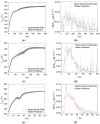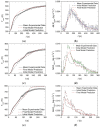Pyrolysis Model Development for a Multilayer Floor Covering
- PMID: 28793556
- PMCID: PMC5512902
- DOI: 10.3390/ma8095295
Pyrolysis Model Development for a Multilayer Floor Covering
Erratum in
-
Correction: McKinnon M.B. and Stoliarov S.I. Pyrolysis Model Development for a Multilayer Floor Covering. Materials 2015, 8, 6117-6153.Materials (Basel). 2015 Nov 11;8(11):7587-7588. doi: 10.3390/ma8115402. Materials (Basel). 2015. PMID: 28793660 Free PMC article.
Abstract
Comprehensive pyrolysis models that are integral to computational fire codes have improved significantly over the past decade as the demand for improved predictive capabilities has increased. High fidelity pyrolysis models may improve the design of engineered materials for better fire response, the design of the built environment, and may be used in forensic investigations of fire events. A major limitation to widespread use of comprehensive pyrolysis models is the large number of parameters required to fully define a material and the lack of effective methodologies for measurement of these parameters, especially for complex materials. The work presented here details a methodology used to characterize the pyrolysis of a low-pile carpet tile, an engineered composite material that is common in commercial and institutional occupancies. The studied material includes three distinct layers of varying composition and physical structure. The methodology utilized a comprehensive pyrolysis model (ThermaKin) to conduct inverse analyses on data collected through several experimental techniques. Each layer of the composite was individually parameterized to identify its contribution to the overall response of the composite. The set of properties measured to define the carpet composite were validated against mass loss rate curves collected at conditions outside the range of calibration conditions to demonstrate the predictive capabilities of the model. The mean error between the predicted curve and the mean experimental mass loss rate curve was calculated as approximately 20% on average for heat fluxes ranging from 30 to 70 kW·m-2, which is within the mean experimental uncertainty.
Keywords: Controlled Atmosphere Pyrolysis Apparatus; ThermaKin; carpet; composites; engineered materials; fire modeling; gasification; material flammability.
Conflict of interest statement
The authors declare no conflict of interest.
Figures


















References
-
- ASTM Standard E1354 . Test Method for Heat and Visible Smoke Release Rates for Materials and Products Using an Oxygen Consumption Calorimeter. ASTM International; West Conshohocken, PA, USA: 2015.
-
- ASTM Standard E2058 . Standard Test Methods for Measurement of Material Flammability Using a Fire Propagation Apparatus (FPA) ASTM International; West Conshohocken, PA, USA: 2013.
-
- ASTM Standard D2859 . Standard Test Method for Ignition Characteristics of Finished Textile Floor Covering. ASTM International; West Conshohocken, PA, USA: 2011.
-
- ASTM Standard E648 . Standard Test Method for Critical Radiant Flux of Floor-Covering Systems Using a Radiant Heat Energy Source. ASTM International; West Conshohocken, PA, USA: 2014.
-
- Marquis D.M., Pavageau M., Guillaume E. Multi-scale simulations of fire growth on a sandwich composite structure. J. Fire Sci. 2012;31:3–34. doi: 10.1177/0734904112453010. - DOI
LinkOut - more resources
Full Text Sources
Other Literature Sources
Miscellaneous

